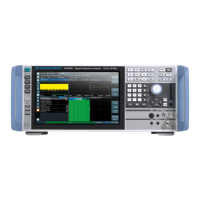Measurements and Results
R&S
®
FSVA3000/ R&S
®
FSV3000
128User Manual 1178.8520.02 ─ 01
7. If necessary, increase the resolution of the signal counter by selecting "Signal
Count Resolution" (in the "Signal Count" menu).
Prerequisites for using the internal signal counter
In order to obtain a correct result when measuring the frequency with the internal sig-
nal counter, an RF sinusoidal signal or a spectral line must be available. The marker
must be located more than 25 dB above the noise level to ensure that the specified
measurement accuracy is adhered to.
7.2.4 Measurement Example – Measuring Levels at Low S/N Ratios
The minimum signal level a signal analyzer can measure is limited by its intrinsic noise.
Small signals can be swamped by noise and therefore cannot be measured. For sig-
nals that are just above the intrinsic noise, the accuracy of the level measurement is
influenced by the intrinsic noise of the R&S FSV/A.
The displayed noise level of a signal analyzer depends on its noise figure, the selected
RF attenuation, the selected reference level, the selected resolution and video band-
width and the detector.
For details see:
●
Chapter 8.4.1.2, "RF Attenuation", on page 368
●
Chapter 8.4.1.1, "Reference Level", on page 366
●
Chapter 8.5.1.1, "Separating Signals by Selecting an Appropriate Resolution Band-
width", on page 377
●
Chapter 8.5.1.2, "Smoothing the Trace Using the Video Bandwidth", on page 377
●
"Mapping Samples to sweep Points with the Trace Detector" on page 486
This measurement example shows the different factors influencing the S/N ratio.
Table 7-2: Signal generator settings (e.g. R&S SMW)
Frequency 128 MHz
Level -95 dBm
1. Preset the R&S FSV/A.
2. Set the center frequency to 128 MHz.
3. Set the span to 100 MHz.
4. Set the reference level to-30
dBm.
The signal is measured with the auto peak detector and is completely hidden in the
intrinsic noise of the R&S FSV/A.
Basic Measurements

